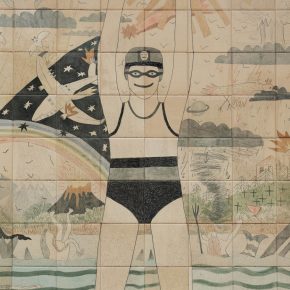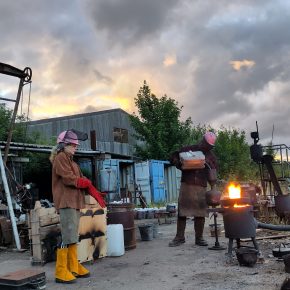Studio conversation with studio holder Kjersti Sletteland
What do you make?
I’m working together with a group of Syrian women who came to Scotland as refugees, and we are going to make a dining table with plates. They’re coming to Southbridge Resource Centre, where I teach ceramics, as part of a residency supported by Craft Scotland and Historic Environment Scotland called Making History.
When did you come here to Edinburgh Sculpture Workshop?
I’ve been here for, probably, ten years. It’s been very good, really nice. You feel a lot of support here and just having these facilities, it’s been great.
Ceramic is your main material.
A material that I’ve always come back to. I did my BA in ceramics, and I was only working in ceramics at first, but then, I branched out and worked with lots of other materials too, from metal to photography, everything. But right now I’ve got a big interest in ceramics again and it’s fun and exciting to experiment with textures and shapes. And this residency with Craft Scotland, inspires me to be really hands-on with ceramics again.
Do you think more of functionality?
I don’t. I’ve never worked properly with functional ceramics. So, this is the first time for me, so no, never.
Small scale or a bigger scale?
I do like working big scale. The way that sculpture occupies the space and the way you have to move around it. But some of my ceramic work has been muted, and detailed, and small. I suppose I like to explore the different effects scale can evoke in the viewer.
Do you do some metal work you said?
Metalwork is what I’ve done the least, but it’s been good to have the facilities here. I would like to explore bronze casting and iron casting, but I haven’t so far, so it’s on my list.
What kind of sculptor would you say you are?
I think it’s an interesting question. I wouldn’t say that I fall into the conceptual side, because I think those artists are very much about the theme, the subject and less about the process. I think I’m very much a maker, so I do a lot of thinking in my studio whilst I’m working. So I don’t go into my studio with a completed plan but more with an open plan to be worked on.

So, you explore shapes and textures.
Yeah, and it’s also about expressing ideas. My work is very much making; hours and hours in the studio, and there are definitely concepts and themes and titles and everything. So, I think it’s for somebody else to decide what kind of sculptor I am. In art schools, they don’t learn so much technique anymore.. I’ve talked to so many people who are envious because I did ceramics at university so I have a deep knowledge in a specific material. The way we were taught was very thorough and it is a good foundation.
You’ve been initiated.
Yeah, and it’s great to have proper knowledge about something. But when I did it, I missed the other side, the fine art side. Which is why I did a masters in Fine Art anyway, to branch out and learn more about fine art and history of fine art. It’s great to have both. I think this has been a good way for me.. to gather skills first and study further afterwards. Some of these are test pieces. I’ve been working hard to achieve cracks in ceramics. For this you must know how clay and different materials respond to each other.
Do you have notes on everything?
Yeah, I’ve done loads and loads of notes. This is the project that I’ve been working on for a few years. This is my most recent piece made of porcelain. Tests can be very elaborate, to see how everything acts all together over glazes and things like that. I started working on this one at the beginning of COVID. I made hundreds and hundreds of little sculptures. Here are lots of things that were happening around me: that building block is in my neighbourhood, these are clowns hats, royal buffoon, stupid politicians, a little sexual reference, because it was also during Me Too movement, and a mention of when the Black Lives Matter movement were pushing down all the statues from their pedestals.

A lot of social and political commentaries in one piece.
There is a cartoon kind of imagery in it and some Bosch and more art history. There are elements from social history as well. It’s important to mention that this series of work started out as a collaboration. For years I’ve been working with another artist, Tone Einelia, she lives in Norway and I live here most of the time, so, we are not making these pieces right now, but you can see that my most recent piece is very similar in style to the works made in collaboration. Working together can be great and we’ve been working together for many years.
You can analyse one for hours. It’s like you have to read every single small sculpture in relation with each other.
The piece definitely needs to be in the middle of a room, to see every side of it.
Does it go ensembled in the kiln?
Everything went in the kiln as one piece. I was quite nervous transporting it down to the kiln, it is very fragile before it is fired. They were made from porcelain and then bisque fired, and then I applied lots of underglazes, all different colours.
You work on very different pieces at the same time.
Yeah, yeah. This is a pillar and then all of a sudden it takes shape, which is interesting when it comes to studio work, you think I’m going to make this pillar, and then, when you’re working and working, it starts going to be lots of elements put together again. I’m just shaping and shaping to get it right.

Are you preparing an exhibition?
I’m working in response to a building called Trinity House which is in Leith. This is part of the Making History residency. It’s important to have something to work towards and a chance to show it. Ceramics as a material is very exciting for me right now and it’s very much about contemporary life, history, my life and what’s happening around.
Studio conversation between Mihaela Coman and ESW studio holder Kjersti Sletteland on 13 March 2023
More about Kjersti’s work here




